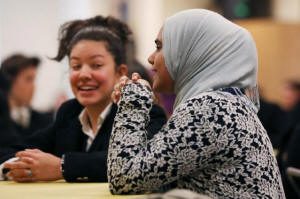|
To ease fears, U.S. Muslim schools reach
out to neighbors
 Send a link to a friend
Send a link to a friend
 [May 12, 2017]
By Laila Kearney [May 12, 2017]
By Laila Kearney
HUNTINGTON, N.Y. (Reuters) - At a Roman
Catholic high school in New York's Long Island suburbs, two dozen
visiting Muslim students knelt and prayed while teens in uniform blazers
from the host school looked on.
The trip's agenda was simple: give students whose schools are just 10
miles (16 km) apart but culturally worlds away a chance to get to know
each other.
It is also part of an ambitious initiative that will be adopted by
nearly 80 U.S. Islamic elementary, middle and high schools starting in
the fall to give Americans a better picture of U.S. Muslims at a time
when many feel targeted by President Donald Trump's administration.
"Sometimes Muslims in today's society are afraid of other people judging
them," Laiba Amjad, a 19-year-old senior at MDQ Academy Islamic school
in Brentwood, New York, said during the visit to Saint Anthony's High
School in nearby Huntington.
"Other people are also afraid," she said, referring to non-Muslims.
"They're thinking, 'What if that person is an extremist?'"
Americans are more likely to view Muslims, who make up 1 percent of the
U.S. population, as extremists if they do not know one personally,
according to a February poll by the Pew Research Center. The same survey
found that 60 percent of Americans who know a Muslim believe there is
little or no support among them for extremism but only 48 percent of
those who do not know a Muslim believe that.

"I hadn't really interacted with many Muslims before this," 17-year-old
Chris Beirne said while he and fellow Saint Anthony's seniors ate lunch
with the visiting Muslim students.
"Muslims typically today are put into this one group with extremists,"
Beirne said. "I think the solution to that problem would be having
events like this."
In an effort to overcome that perception, the Council of Islamic Schools
in North America, the nation's only accrediting agency for Muslim
schools, is changing its curriculum. It will ask its 78 accredited or
member schools, located across 24 U.S. states, to arrange meetings
between their own students and those at other, non-Muslim schools.
"People in this country, they want to know about Muslims, they want to
know what's going on inside Islamic schools," said CISNA Director Sufia
Azmat.
The Council is asking its educators to launch more volunteer projects
outside the Muslim community, attend local government meetings and
create a database of alumni to track their graduates' success.
The move comes at a time when Muslims are under intense scrutiny,
largely the result of extremist attacks carried out in the name of Islam
in the United States and abroad.
In the deadliest mass shooting in modern U.S. history, an American-born
gunman pledging allegiance to various Islamic militant groups shot 49
people to death at a nightclub in Orlando, Florida, last June.
Mainstream Muslim religious leaders condemn the violence, saying their
faith forbids it. Muslims are the second-most targeted religious group
in the United States for hate crimes, behind Jews, according to the
latest statistics from the Federal Bureau of Investigation.

A report by the Council on American-Islamic Relations released this
month showed a 57 percent spike in the number of anti-Muslim hate crimes
recorded in the United States last year compared with 2015.
[to top of second column] |

Students from the MDQ Academy Islamic School and Saint Anthony's
High School sit in a cafeteria during a field trip at the Roman
Catholic school in Huntington, New York, U.S., April 26, 2017.
REUTERS/Shannon Stapleton

In the 10 days following U.S. Election Day on Nov. 8, physical and
verbal attacks against Muslims ticked up 6 percent compared to the
same period the prior year, the Southern Poverty Law Center said.
'BE OPEN'
The details of the U.S. Islamic schools' new curriculum are still
being hammered out, but the purpose is clear, CISNA's Azmat said:
"Be open to outsiders."
A recent study of about a third of the nation's Muslim high schools
conducted by the Institute for Advanced Studies in Culture at the
University of Virginia found that the students did not vary much
from their non-Muslim peers in terms of interests and sense of being
American.
"These are very, very typical kids in a lot of ways, but also see
themselves as Muslims and objecting to some things in American
society just as a lot of Evangelical (Christian) and Jewish kids
would," said Charles Glenn, an education policy expert who led the
study of Islamic schools.
Many of the nation's Islamic schools have kept a low profile since
the first school opened in the United States roughly 30 years ago,
partly to avoid harassment.
The outreach efforts could face similar resistance to those of U.S.
public schools that have attempted to teach about Muslims in social
studies classes. Some parents in San Diego, California, and Chatham,
New Jersey, recently objected to lessons about Muslims.
"You have given your alliance to people that are against our own
Constitution," Alice Kaiser, who is part of a group opposing the San
Diego Unified School District's anti-Islamophobia program, said
about the program at a school board meeting late last month.

The Al Fatih Academy, an Islamic school in Reston, Virginia, has
been used as a model by CISNA for community outreach.
On Election Day, a group of Al Fatih eighth graders concerned about
anti-Muslim rhetoric asked voters at a polling station about the
political issues they cared about most. Some of the longest
conversations were with Trump supporters, many of whom said they had
never spoken to a Muslim before, according to principal Afeefa
Syeed.
"At the end of the day, if we have more of these conversations and
actions, it's better for everyone," Syeed said.
(Reporting by Laila Kearney; Editing by Scott Malone and Matthew
Lewis)
[© 2017 Thomson Reuters. All rights
reserved.]
Copyright 2017 Reuters. All rights reserved. This material may not be published,
broadcast, rewritten or redistributed. |